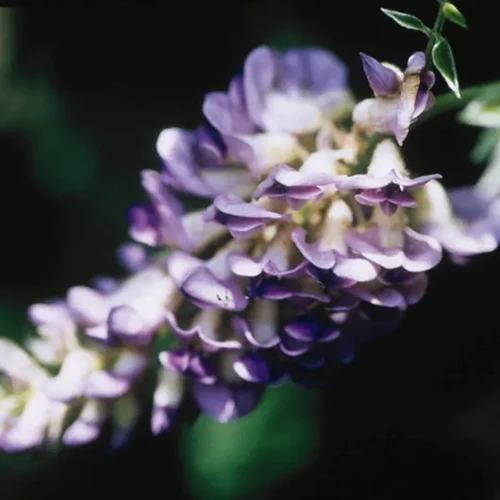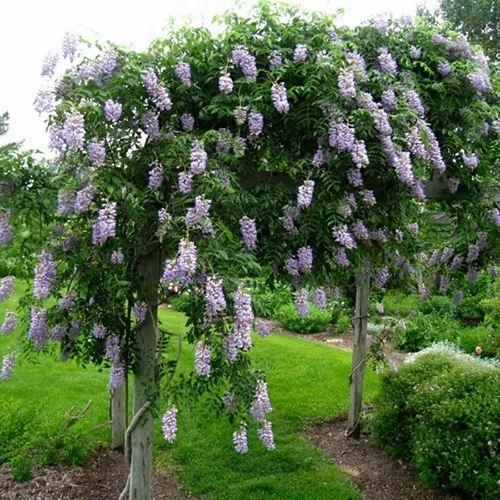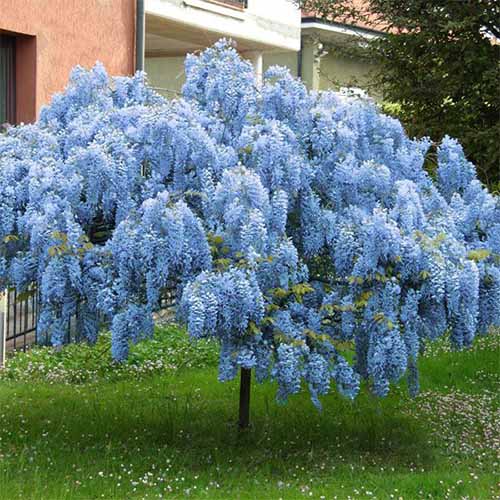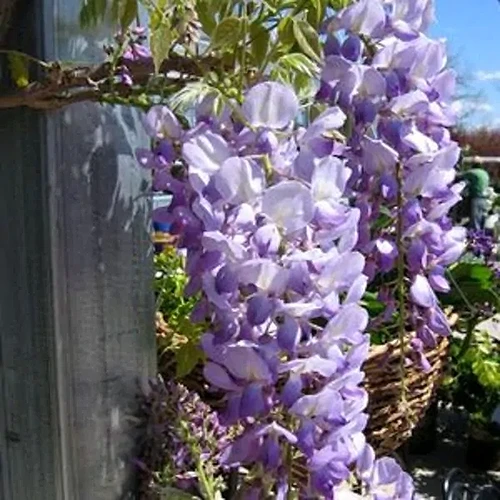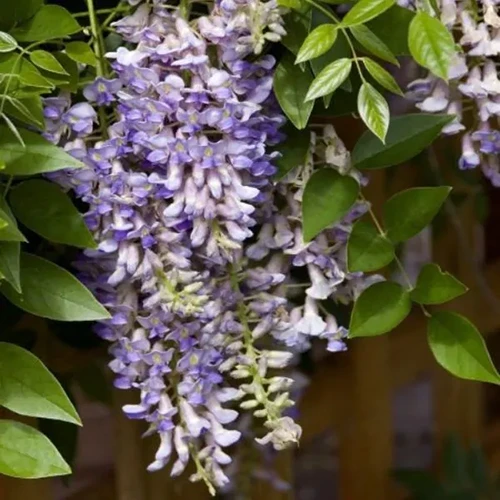Quick! Picture a wisteria vine. I bet you conjured up something with lilac flowers on long racemes. Maybe you even imagined an aggressive woody vine that will try to take over your garden.
Forget all that.
While you can always find the classic wisteria described above, there are so many other wonderful wisteria options out there these days.
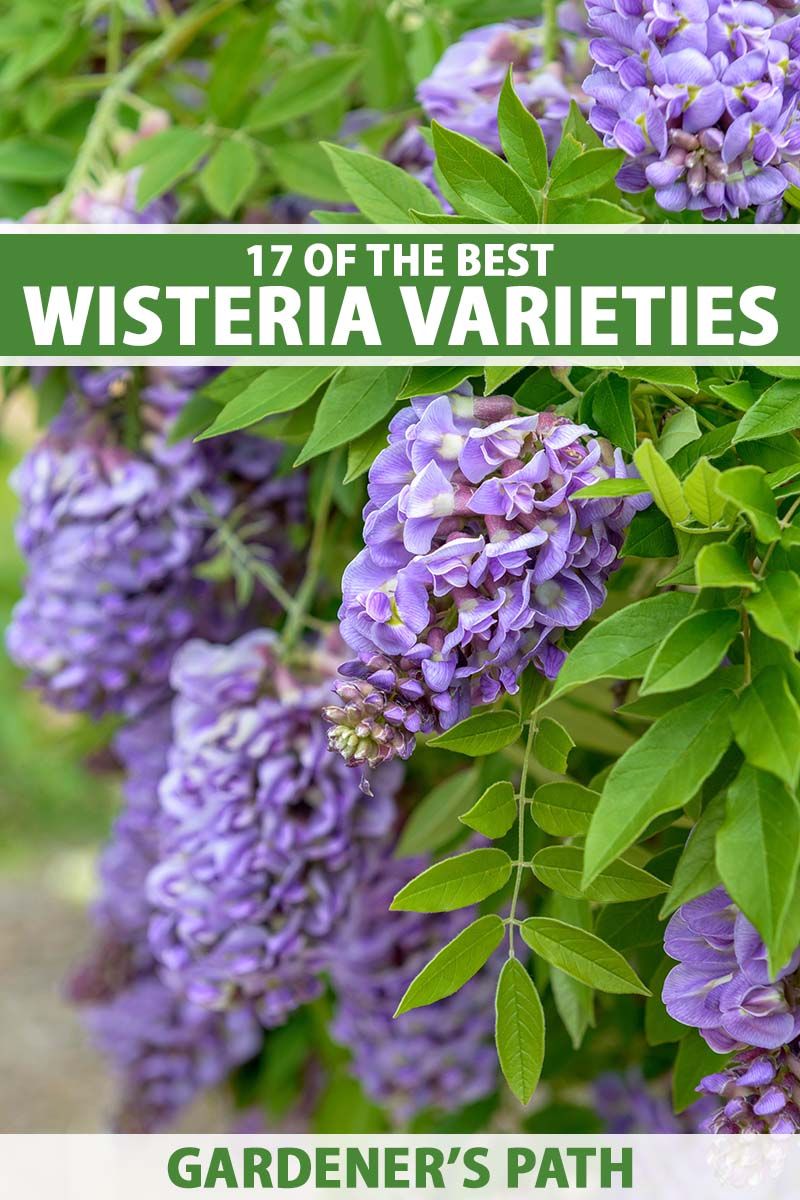
We link to vendors to help you find relevant products. If you buy from one of our links, we may earn a commission.
You can find dark purple, pale pink, true white, and sky blue petals on racemes that can range from six inches to two feet long, on plants that might stay a petite 10 feet or stretch three times that far.
Some newer options will rebloom for a second time later in the year and there are many North American natives that won’t become invasive.
We’ve rounded up a few of the best. Here are the ones we’ll chat about:
17 of the Best Varieties of Wisteria
Most are hardy in USDA Zones 5 to 9, but we’ll point out any that deviate from this.
If you are new to growing wisteria, be sure to check out our guide for cultivation tips.
1. Amethyst Falls
Asian types are the most popular commercially, but ‘Amethyst Falls’ is pretty darn successful for an American (Wisteria frutescens) cultivar, and for good reason.
It was discovered as a stem mutation by South Carolina growers Bill and Bob Head, and it has proven to be a reliable, vigorous grower that reblooms a few months after the initial flush of flowers.
The lavender-blue flowers appear in clusters about six inches long on 10-foot-long vines.
For a tough, prolific, and beautiful waterfall-like cascade of blossoms, snag a two-gallon, five-gallon, two- to three-, or three- to four-foot plant at Fast Growing Trees.
2. Aunt Dee
For my money, ‘Aunt Dee’ is pretty hard to beat.
As a Kentucky (W. macrostachya) cultivar, it won’t become invasive, and it can withstand extremely cold temperatures as far north as Zone 4, in addition to drought.

It will continually perform with 12-inch-long clusters of lilac-blue blossoms with white centers, creating a sort of ombre look. Once mature, the vines can grow 30 feet long.
On top of that, it’s seemingly impervious to pests and diseases, as well as road salt. It’s a wisteria that you can trust not to take over while still sticking around through thick and thin.
This is one aunt that you’ll love to have around all the time! Purchase one at Nature Hills Nursery.
3. Blue Moon
W. macrostachya ‘Blue Moon’ is a Kentucky cultivar, bred from a species that grows indigenously in the midwest and south.
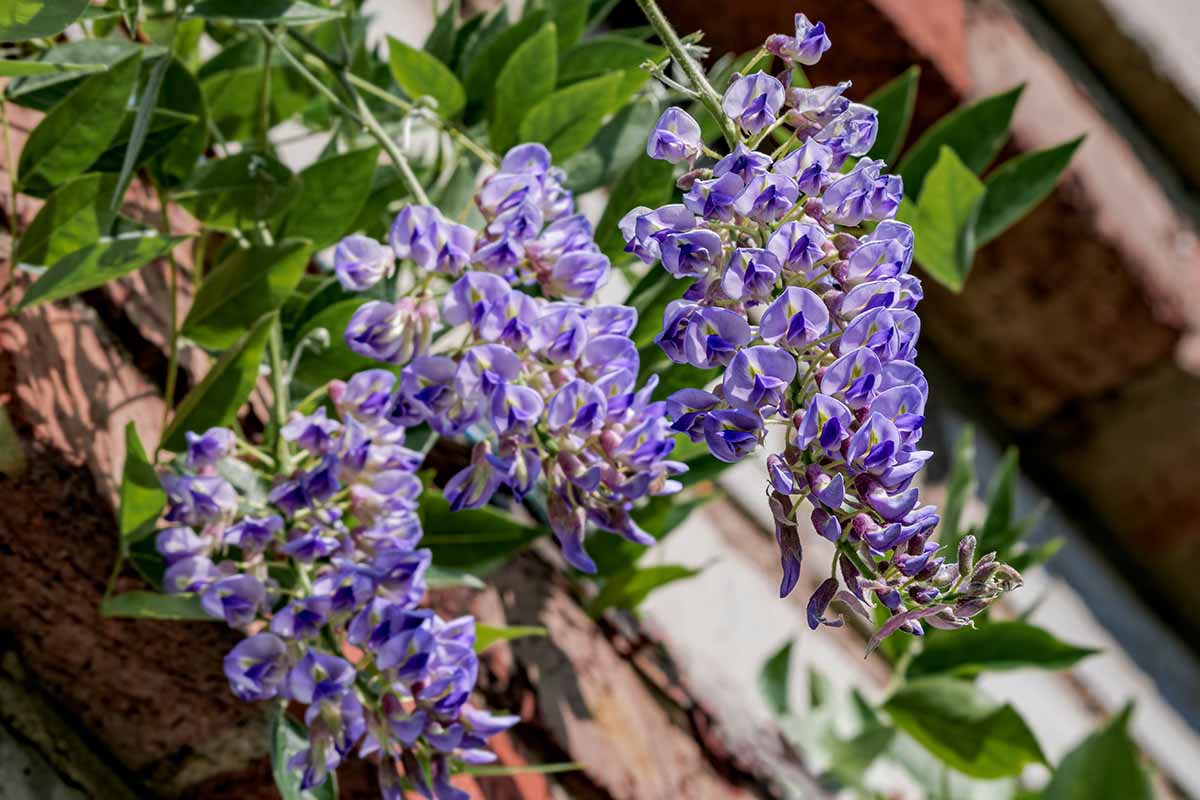
It’s more aggressive than its close relative American wisteria (W. frutescens) and has longer racemes that grow up to a foot long.
Despite its somewhat aggressive growth, it’s not nearly as intense as its Asian counterparts, and it won’t become invasive.
It’s extremely hardy, growing as far north as Zone 3 and stretching up to 25 feet long.
Nature Hills Nursery has ‘Blue Moon’ available in #2 containers, or you can grab one from Fast Growing Trees in quart, two-gallon, or two- to three-foot-tall options.
4. Chinese
The Chinese species (W. sinensis) is beautiful. But it’s also an extremely aggressive grower.
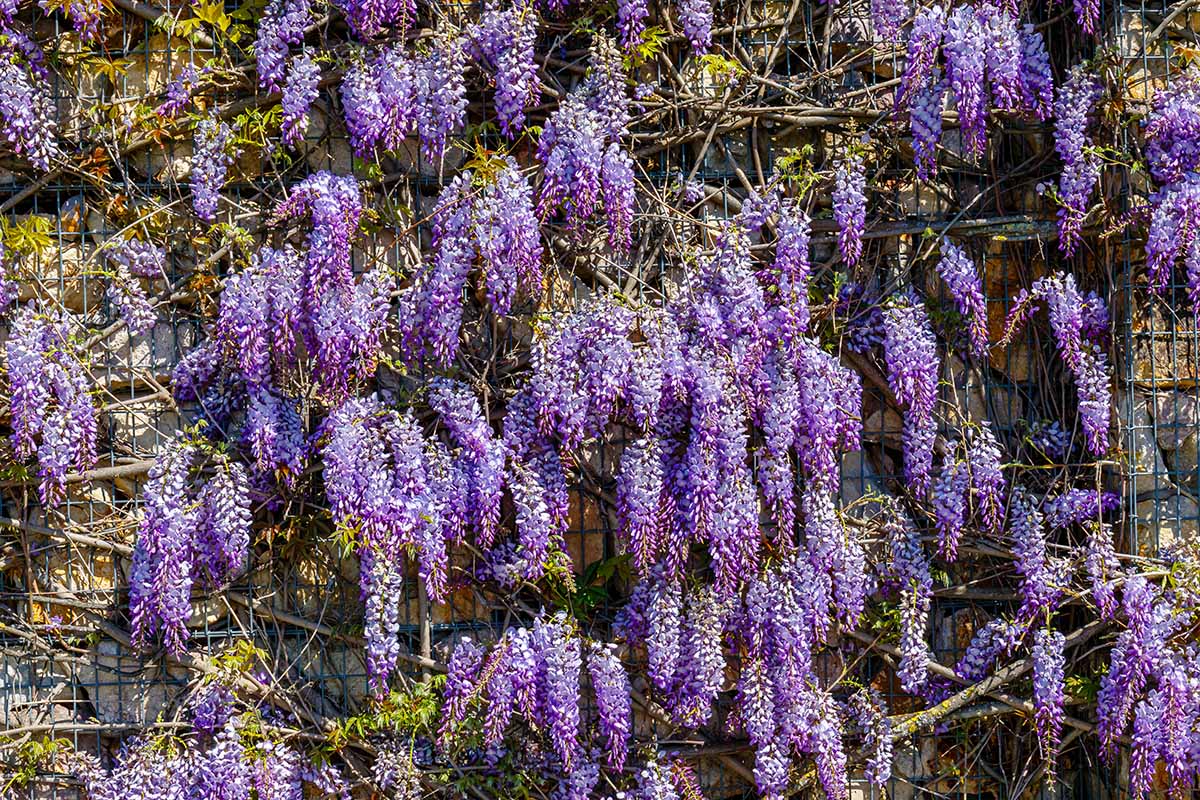
It’s one of those varieties that some homeowners are trying to get rid of rather than adding to their yards. But in the right (contained) conditions, it can be a magnificent specimen that can reach up to 30 feet long.
If you’re in the southeast, you should probably skip this one. Some states even consider it to be invasive and it’s illegal to purchase there. Check your local regulations.
The 12-inch-long racemes are lavender and purple with a hint of blue, and they emerge all at the same time. This makes for an extremely eye-catching display.
Nature Hills Nursery carries this beauty trained as a tree in several different sizes.
5. Cooke’s Purple
‘Cooke’s Purple’ is a Chinese (W. sinensis) cultivar that earned its reputation as one of the first summer reblooming types.
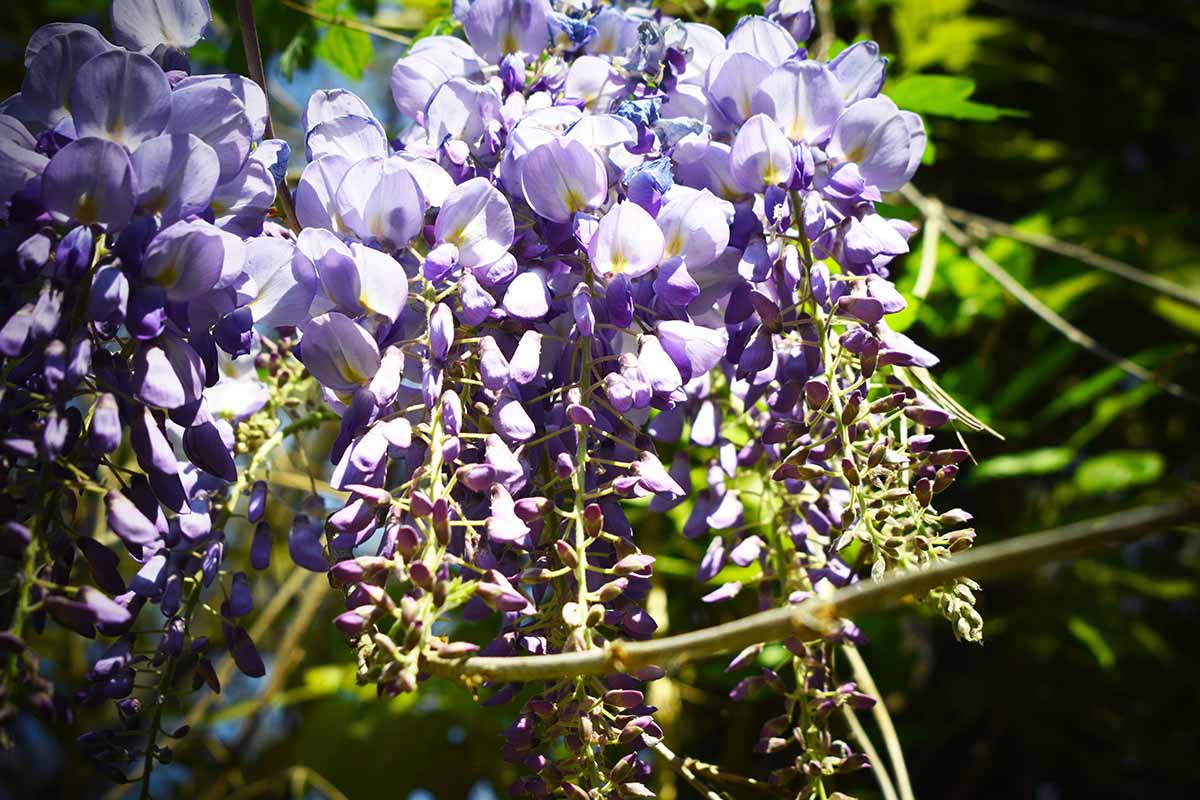
It puts on a magnificent show in spring before returning for an encore performance in summer.
These days, you can find many other wisterias that do the same, but ‘Cooke’s Purple’ put the long-blooming types on the map after noted nurseryman Robert Ludekens was introduced to a surprising seedling by his optometrist Dr. James Miller in the early ‘60s.
There’s a reason that ‘Cooke’s Purple’ has stayed on the market despite the competition. See for yourself by grabbing one from Nature Hills Nursery.
The plant will grow up to 30 feet tall while being slightly less aggressive than the species.
6. Grande Diva
Grande Diva is a series of W. floribunda cultivars named after opera singers, produced by Minier Nursery in France.
Right now, you’ll find ‘Barbara’ and ‘Jessye’ on the market. They were named for Jessye Norman and Barbara Hendrix.
‘Barbara’ has bold purple and white blossoms on six-inch-long racemes, and it blooms so generously that you might not be able to see any of the bark or stems holding the whole thing up.
‘Jessye’ is a repeat bloomer with darker blossoms than ‘Barbara’ and it is just as floriferous. It’s also heavily fragrant and the double blossoms will bloom even in partial shade.
Both grow up to 30 feet tall.
7. Jako
‘Jako’ is a Chinese (W. sinensis) cultivar that has earned a place in many gardens, and no wonder.
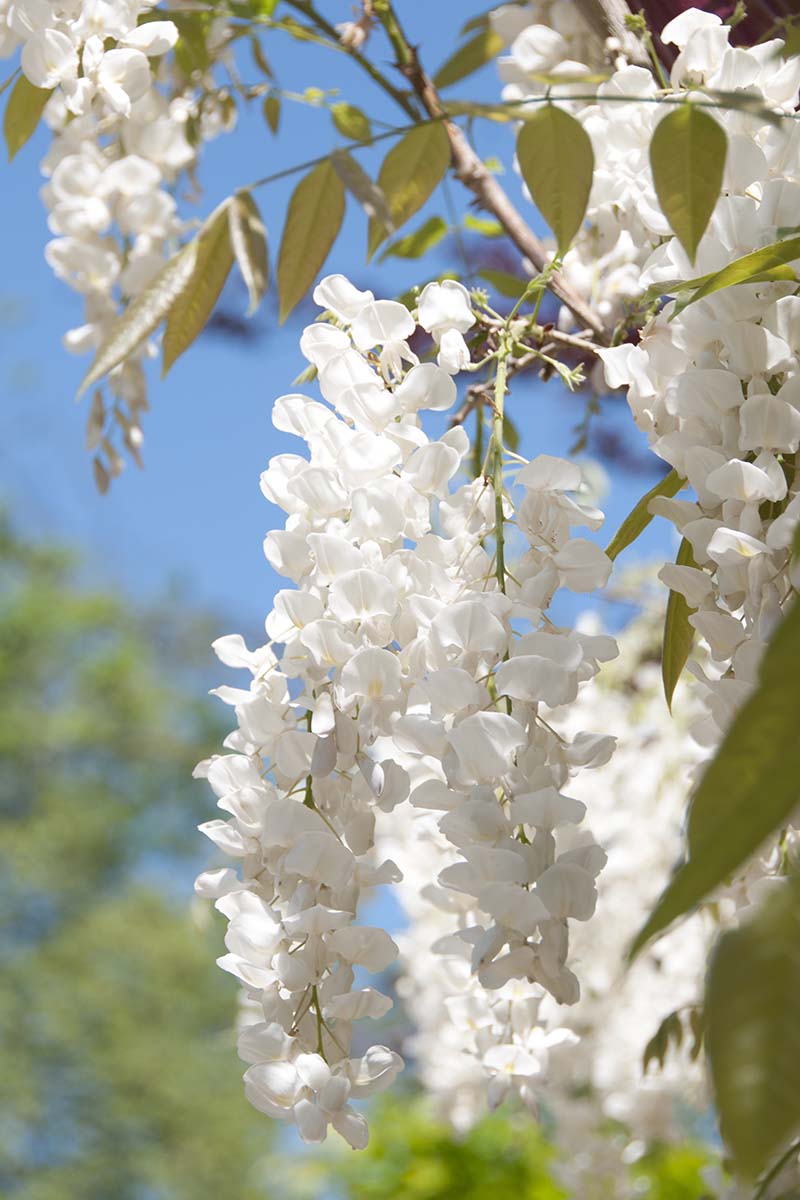
The 12-inch-long racemes are dripping with pure white blossoms for a simple and elegant display. But it’s not just a feast for the eyes – the scent is out of this world, it’s so intense.
The flowers persist from early spring for a good long while on a plant that can reach up to 30 feet long.
8. Kimono
This W. floribunda cultivar is dressed up in an elegant robe of fragrant white and pale violet blossoms on foot-long racemes.
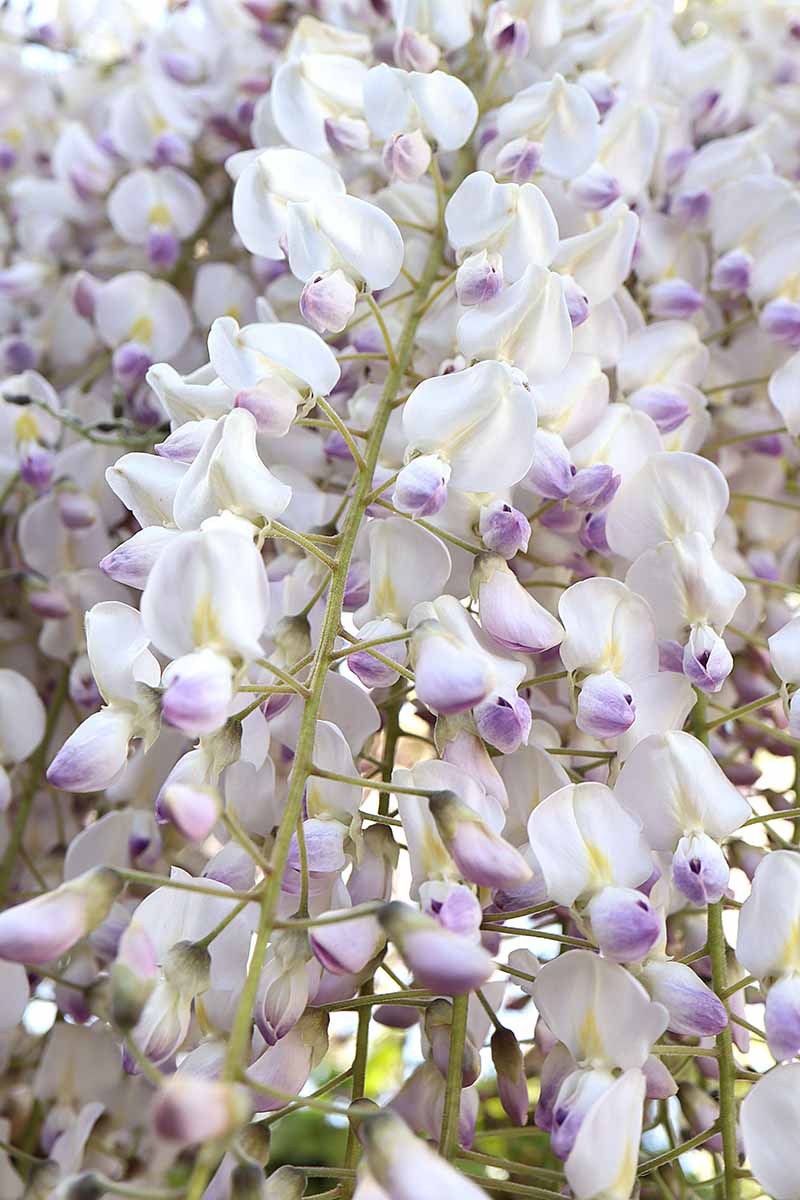
This one stays a bit smaller than many others in the species, topping out at about 10 feet, and it has a thick, strong trunk, making it a popular option for training into a tree.
Unlikely to become invasive, it’s still plenty tough, adaptable, and vigorous. You might see it listed as ‘White with Blue Eye,’ describing the white petals with their pale violet center.
9. Lavender Falls
This W. floribunda cultivar was bred in Oklahoma and has become massively popular on the commercial market. It’s obvious why.
The lavender racemes are huge, up to 20 inches long, and abundant on an extremely vigorous vine. As if that wasn’t enough to recommend it, the vines will bloom a second time in the summer.
‘Lavender Falls’ is actually the only common rebloomer that has full-sized racemes. It has vines that reach up to 20 feet long.
I totally understand if you want to have this one in your yard. It’s pretty stunning. Just be sure to keep up with your pruning. You don’t want too much of a good thing.
If you’ve fallen in love with ‘Lavender Falls,’ bring the beauty home from Nature Hills Nursery.
10. Lavender Lace
Sometimes breeders come up with the absolute perfect name for their plants. ‘Lavender Lace’ is one of those.
From far away, it looks like this tree is covered head to toe in yards and yards of lavender-colored lace.
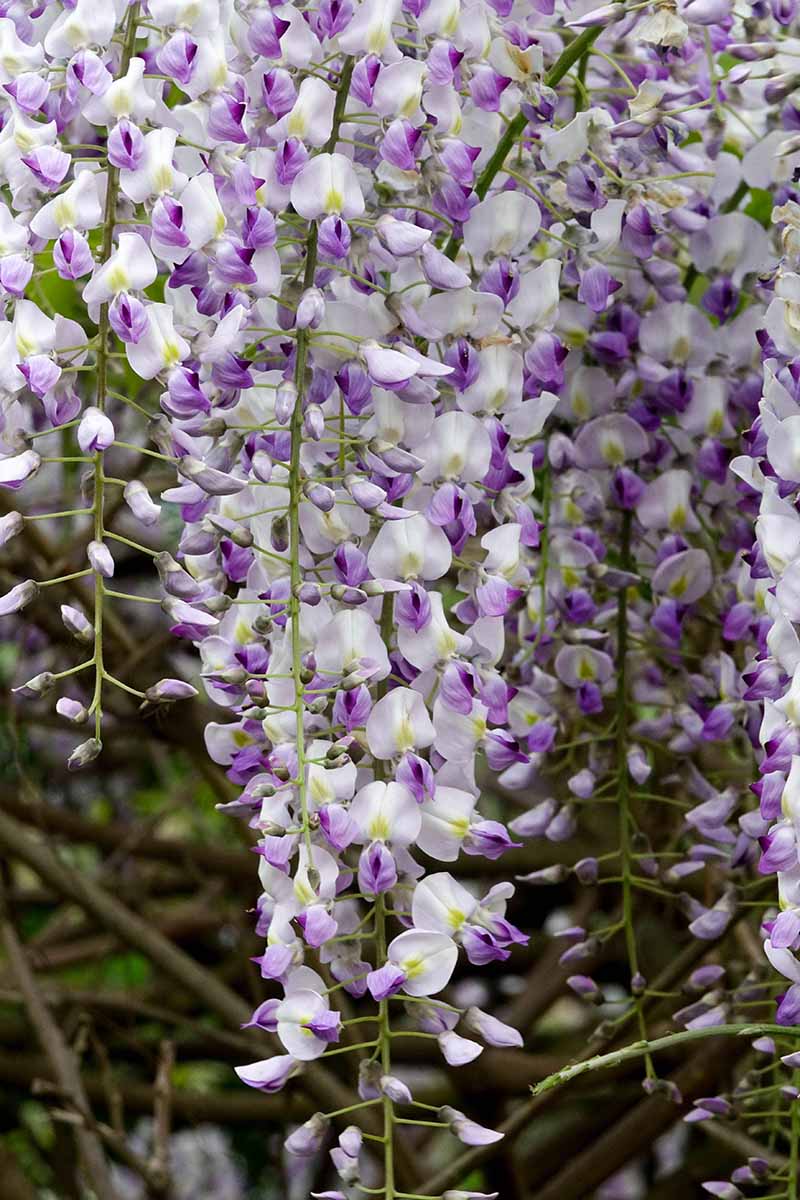
The racemes on this W. floribunda cultivar are huge, nearly 20 inches long, with multi-hued white, lavender, and violet blossoms.
And there are a ton of them. When it’s blooming, it’s difficult to see the stems on this 30-foot-tall plant.
This cultivar is a vigorous grower, and it can become invasive if you plant it in the right (or wrong) area.
11. Lawrence
‘Lawrence’ is a W. floribunda cultivar that regularly makes lists as one of the best of the species.
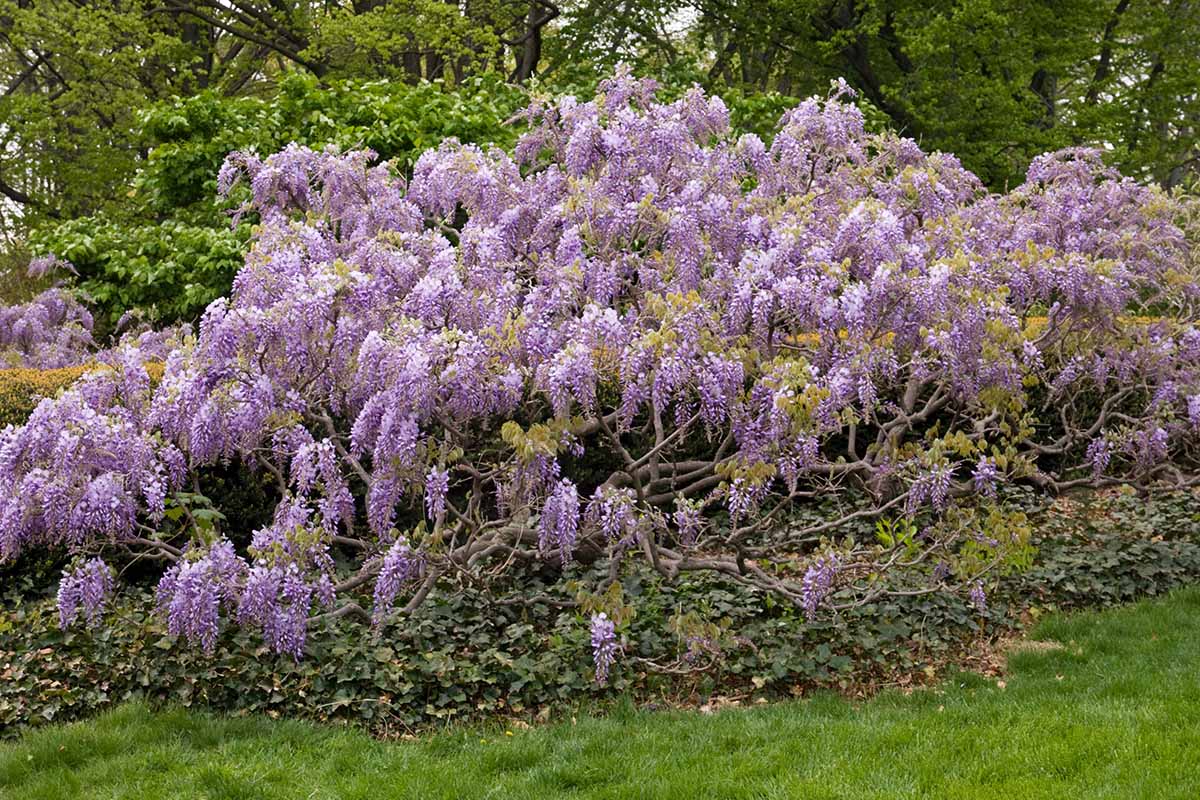
That’s because each raceme is absolutely packed with fragrant blossoms. Seriously, each 20-inch raceme could have upwards of 170 pale blue-lavender flowers.
Imagine how stunning this one is when the 30-foot-long vines are all dressed up in flowers. No wonder it nabbed the coveted Award of Garden Merit from the Royal Horticultural Society in 2012.
12. Longwood Purple
Blooming in mid-spring through summer with clusters of upright racemes of medium purple petals, this American (W. frutescens) cultivar establishes itself quickly.
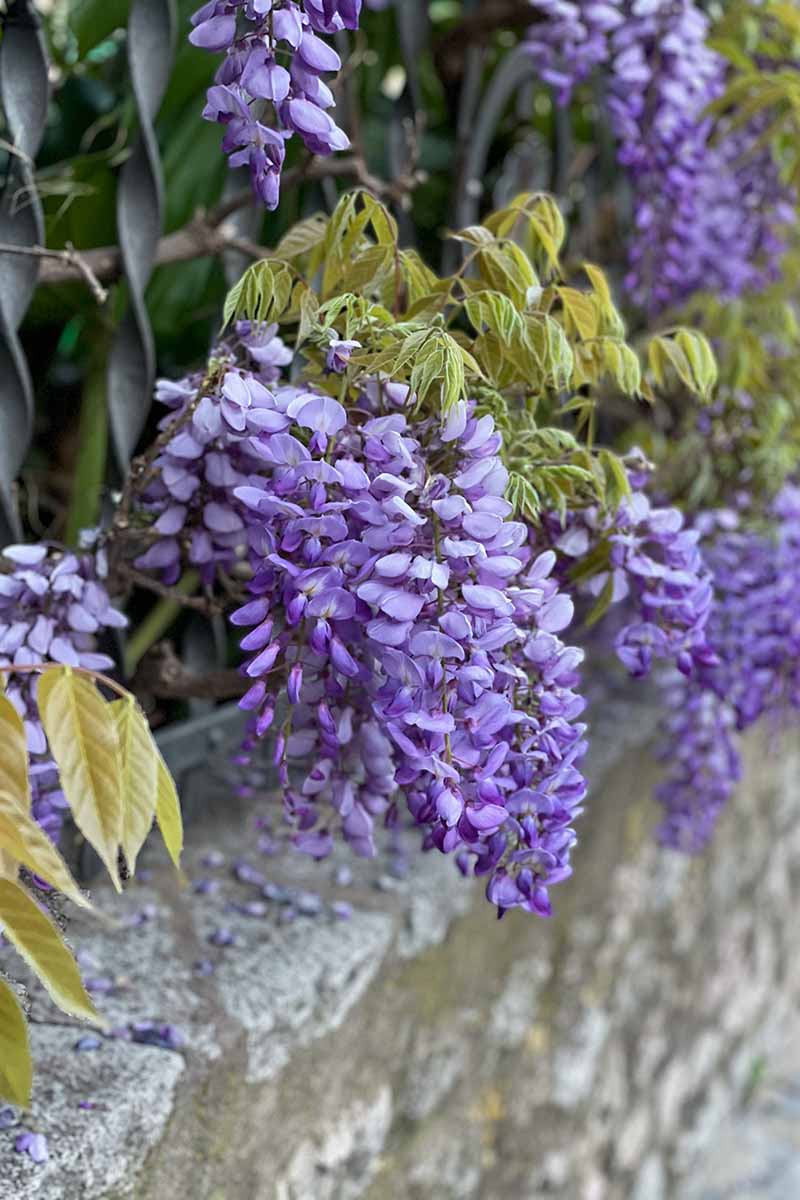
That doesn’t mean it’s invasive, though. It stays politely in its area, and it grows to an easily maintainable 15 feet tall. It even performs well in dappled shade.
13. Nivea
A North American (W. frutescens) native cultivar, ‘Nivea’ grows up to 25 feet long and blooms with short racemes of bright white blossoms.
Though they aren’t as long and elegant as those of some other types, they make up for it with their heavenly fragrance.
You can plant ‘Nivea’ in Zones 4 to 9. And while this is a reliable grower, it will grow vigorously without becoming invasive.
14. Okayama
W. brachybotrys is often called silky wisteria, and you will love the six-inch-long clusters of silky-looking dark violet, lavender, and white blossoms on the cultivar known as ‘Okayama.’

The flowers are heavily fragrant and – fun fact alert! – the species is one of few counter-clockwise twining wisterias.
It will grow up to 20 feet tall but won’t take over the area where you plant it.
15. Rosea
‘Rosea’ is a Japanese type (W. floribunda) that can also be found under the names ‘Hon-beni,’ ‘Honko,’ and ‘Pink Ice.’
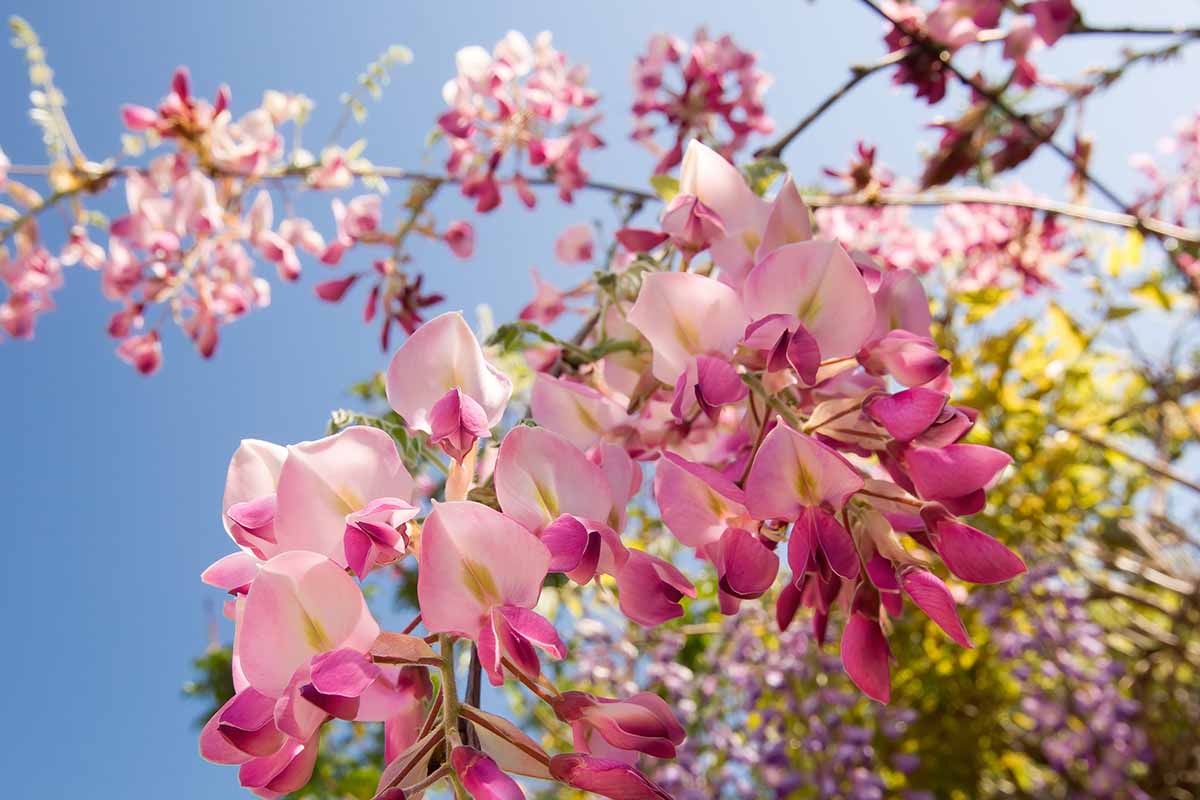
It has intensely fragrant pink clusters of blossoms that can be up to two feet long on a 25-foot vine. At the heart of each pearl-like petal is a golden center.
Taken all together, it makes for a unique and magical display when it’s in bloom.
Though it’s a W. floribunda cultivar, it won’t become as aggressive as some of the others in this species. It’s not as cold-hardy as some other types and should only be grown in Zones 6 and above.
16. Shiro-Kapitan
‘Shiro-Kapitan’ is a stand-out W. brachybotrys cultivar with intensely fragrant, bright white blossoms. While it’s a bit slower to establish itself, once it does, it will take off.
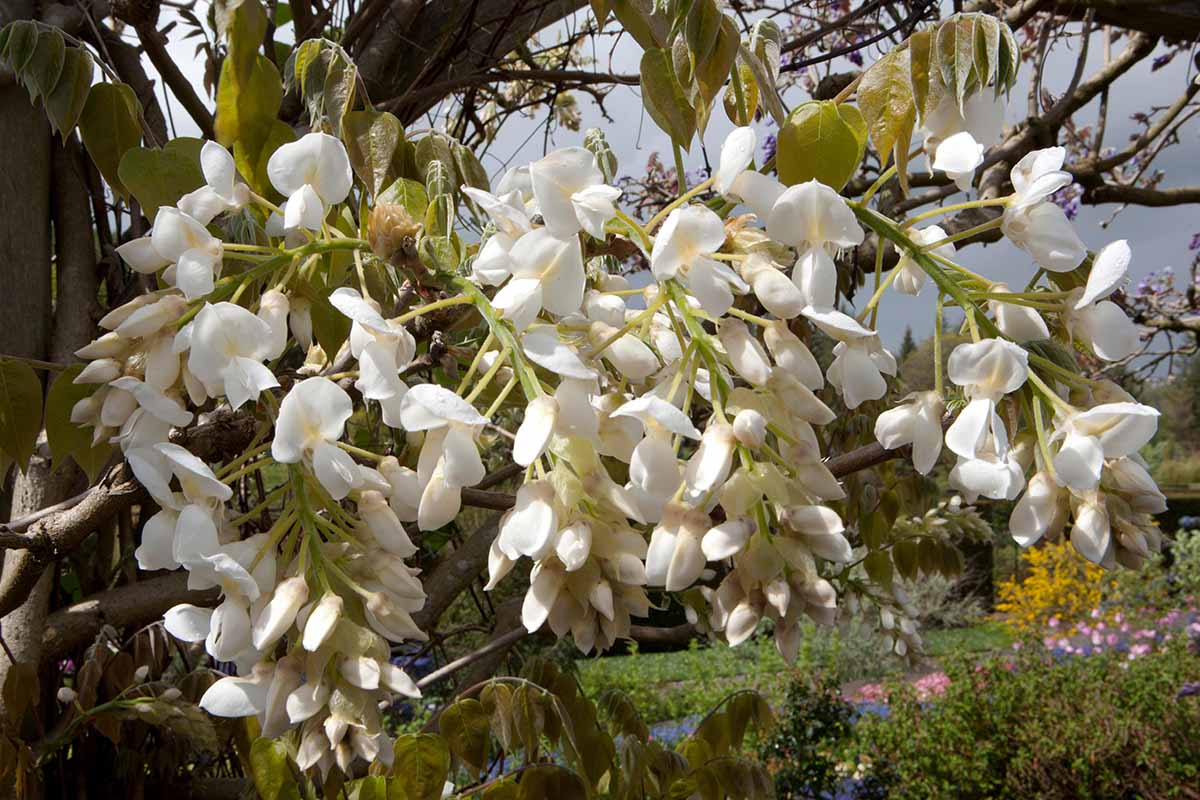
It grows counterclockwise and can reach 25 feet tall. This cultivar can be challenging to find in North America.
17. Summer Cascade
Summer Cascade (W. macrostachya ‘Betty Matthews’) is a Kentucky wisteria cultivar bred by First Edition.
Good old Betty can grow practically anywhere in the US, all the way from Zone 4 through 8.
The 12-inch-long lavender and white flowers that smother the 20-foot vine would be reason enough to recommend it, but it will also rebloom up to two additional times into the summer.
And as a Kentucky species, it’s less likely to grow out of control and take over your garden than Japanese types.
People in colder regions, rejoice! You’ve got wisteria options. Pick up a bare root plant at Nature Hills Nursery.
So Many Wisterias, So Little Time
You can’t go wrong with a classic lavender wisteria, but with so many interesting options, there’s no reason to stick with the basics.
There are non-invasive natives, those with pearl pink petals, and reblooming options to play with.
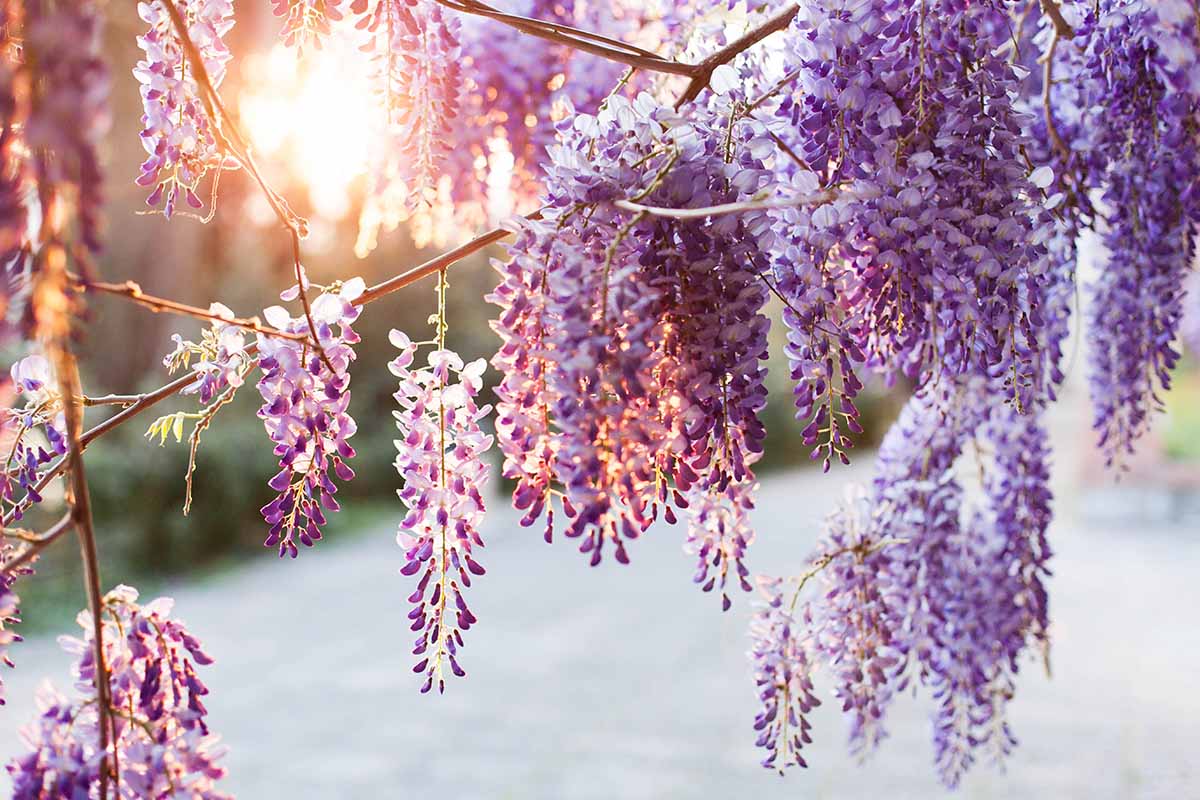
So, the real question is, which one will you pick? Or did we miss one that you particularly love? Give us the details in the comments.
Got the flowering vine bug? We have a few other guides that might catch your fancy. Check these out next:

